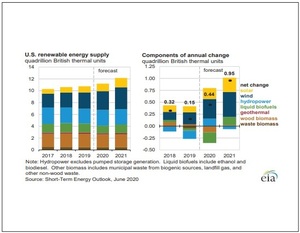U.S. electricity generation from renewable sources is expected to reach 21 percent in 2020 and 23 percent in 2021, up from 17 percent in 2019, according to date released by the U.S. Energy Information Administration in its latest Short-Term Energy Outlook on June 9. Electricity generation from natural gas is expected to increase to 41 percent this year, but fall to 36 percent in 2021 due to higher natural gas prices. Coal is expected to be used to generate 17 percent of U.S. electricity this year, increasing to 20 percent in 2021. Nuclear generation is expected to account for 22 percent in 2020 and 21 percent in 2021.
In the electric power sector, biomass is expected to be used to generate 26.9 billion kilowatt hours (kWh) of electricity this year, increasing to 28.8 billion kWh next year. Biomass was used to generate 28.8 billion kWh of electricity in 2019. That volume of consumption includes 15.2 billion kWh from waste biomass and 11.7 billion kWh from wood biomass this year, with production from wood waste biomass increasing to 15.5 billion kWh and production from wood biomass increasing to 13.2 billion kWh in 2021. Approximately 15.7 billion kWh from waste biomass and 13 billion kWh from wood biomass was generated last year.

Across other sectors, biomass is expected to be used to generate 29.6 billion kWh this year, including 2.8 billion kWh from waste biomass and 26.8 billion kWh from wood biomass. Those levels are expected to remain stable in 2021 and are relatively flat when compared to 2019.
The electric power sector is expected to consume 0.229 quadrillion Btus (quad) of waste biomass this year, down from 0.236 quad in 2019. Consumption of waste biomass is expected to increase to 0.235 quad in 2021. The sector is also expected to consume 0.19 quad of wood biomass in 2020, increasing to 0.214 quad in 2021. The sector’s consumption of wood biomass was at 0.211 quad in 2019.
The industrial sector is expected to consumption 0.164 quad of waste biomass in both 2020 and 2021, up from 0.16 quad in 2019. The sector is also expected to consume 1.372 quad of waste biomass this year, falling to 1.363 quad in 2021. The industrial sector consumed 1.473 quad of waste biomass in 2019.
The commercial sector is expected to consume 0.036 quad of waste biomass and 0.084 quad of wood biomass in both 2020 and 2021. Those levels of consumption are flat with 2019.
The residential sector is expected to consume 0.525 quad of wood biomass in 2020 and 2021, down slightly from 0.529 quad in 2019.
Across all sectors, the consumption of waste biomass is expected to be at 0.429 quad this year, increasing to 0.434 quad in 2021, compared to 0.433 quad in 2019. Wood biomass consumption is expected to be at 2.171 quad this year, increasing to 2.186 quad in 2021. Approximately 2.297 quad of wood biomass was consumed last year.
Total biomass capacity in the electric power sector is expected to reach 6,736 megawatts (MW) by the end of 2020, increasing to 6,746 MW by the end of 2021. Approximately 6,775 MW of capacity was in place at the end of 2019. Wood biomass capacity in the sector is expected to be at 4,009 MW this year, increasing to 4,019 MW in 2021, compared to 4,048 MW in 2019. Wood biomass capacity was at 2,727 MW at the end of 2019. That level of capacity is expected to be maintained in 2020 and 2021.
Across other sectors, biomass capacity is expected to be at 6,456 MW this year, falling to 6,415 MW in 2021, compared to 6,452 MW in 2019. Waste biomass capacity was at 784 MW in 2019 and is expected to reach 800 MW this year and fall slightly to 799 MW in 2021. Wood biomass capacity was at 5,668 MW at the end of 2019 and is expected to fall to 5,656 MW this year and 5,616 Mw in 2021.